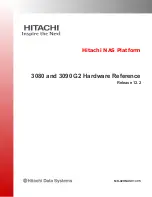
Parallel SCSI Interface Product Manual, Rev. A
113
6.0
SPI information units
An information unit transfer transfers data in SPI information units. The order in which SPI information units are
transferred within an information unit transfer follows a prescribed sequence. When information unit transfers
are enabled, only SPI information units shall be transferred within the DT DATA OUT phase and DT DATA IN
phase.
The SPI information unit sequences shall be as shown in figures 15, 16, 17, and 18. See figures 12 and 13 for
the sequencing rules between the DT Data In or DT DATA OUT phases and the other phases.
For information on information unit exception handling, see sections 3.5.2.2.1.1 and 3.5.2.2.1.2.
The normal progression is from SPI L_Q information unit/SPI command information unit pairs, to SPI L_Q
information unit/SPI data information unit pairs, to SPI L_Q information unit/SPI status information unit pairs.
Note.
a SCSI initiator port may request a BUS FREE phase by creating an attention condition and sending a
DISCONNECT message on the corresponding MESSAGE OUT phase. This allows a SCSI initiator
port to request the target break up a long sequence of SPI L_Q information unit/SPI data information
unit pairs into smaller sequences.
After message phases complete that contain any negotiation (such as, PPR, WDTR, or SDTR) that results in
UI_REQ being changed, the SCSI target device shall abort all tasks, except the current task, for the initiator
participating in the negotiation and the SCSI initiator shall abort all tasks, except the current task, for the target
device.
When an information unit transfer agreement is in effect, there is no option equivalent to the “physical discon-
nect without sending a save Data Pointer message.” The initiator shall save the data pointers as soon as the
last byte of the last iuCRC for a SPI information unit is transferred. The save shall occur even if the initiator
detects an error in the SPI data information unit.
The target shall not start a new information unit transfer until all previous REQ(s) have been responded to by
an equal number of ACK(s) except during a sequence of SPI data stream information units (see Section 6.2.4).
6.1
Information unit transfer logical operations
SCSI devices using information unit transfers may transfer SPI information units for any number of I/O pro-
cesses by using logical connects, logical disconnects, and logical reconnects.
If there are no phase changes to a MESSAGE OUT phase or a MESSAGE IN phase, then logical disconnects
shall occur at the completion of:
a. each SPI command information unit;
b. each SPI status information unit;
c. each SPI data information unit;
d. any SPI L_Q information unit if SPI L_Q information unit Data Length field is zero; and
e. the last SPI data stream information unit.
At completion of those SPI information units the I_T_L_Q nexus becomes an I_T nexus. The I_T nexus
remains in place until the target does a physical disconnect or an I_T_L_Q nexus is reestablished by the target
transmitting a SPI L_Q information unit.
Summary of Contents for Ultra 160
Page 1: ...Parallel SCSI Interface Ultra 160 Ultra 320...
Page 2: ......
Page 3: ...Parallel SCSI Interface Ultra 160 Ultra 320...
Page 6: ...iv Parallel SCSI Interface Product Manual Rev A...
Page 14: ...xii Parallel SCSI Interface Product Manual Rev A...
Page 64: ...50 Parallel SCSI Interface Product Manual Rev A...
Page 144: ...130 Parallel SCSI Interface Product Manual Rev A...
Page 184: ...170 Parallel SCSI Interface Product Manual Rev A...
Page 185: ......














































